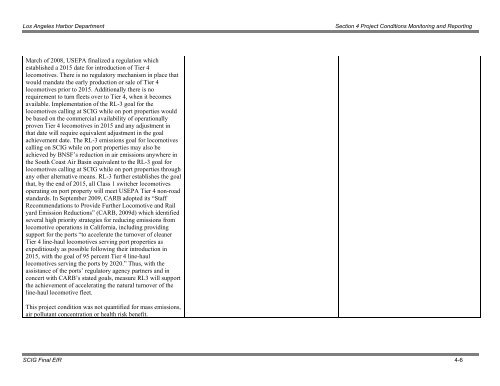Final Mitigation Monitoring and Reporting Program (MMRP)
Final Mitigation Monitoring and Reporting Program (MMRP)
Final Mitigation Monitoring and Reporting Program (MMRP)
You also want an ePaper? Increase the reach of your titles
YUMPU automatically turns print PDFs into web optimized ePapers that Google loves.
Los Angeles Harbor Department<br />
Section 4 Project Conditions <strong>Monitoring</strong> <strong>and</strong> <strong>Reporting</strong><br />
March of 2008, USEPA finalized a regulation which<br />
established a 2015 date for introduction of Tier 4<br />
locomotives. There is no regulatory mechanism in place that<br />
would m<strong>and</strong>ate the early production or sale of Tier 4<br />
locomotives prior to 2015. Additionally there is no<br />
requirement to turn fleets over to Tier 4, when it becomes<br />
available. Implementation of the RL-3 goal for the<br />
locomotives calling at SCIG while on port properties would<br />
be based on the commercial availability of operationally<br />
proven Tier 4 locomotives in 2015 <strong>and</strong> any adjustment in<br />
that date will require equivalent adjustment in the goal<br />
achievement date. The RL-3 emissions goal for locomotives<br />
calling on SCIG while on port properties may also be<br />
achieved by BNSF’s reduction in air emissions anywhere in<br />
the South Coast Air Basin equivalent to the RL-3 goal for<br />
locomotives calling at SCIG while on port properties through<br />
any other alternative means. RL-3 further establishes the goal<br />
that, by the end of 2015, all Class 1 switcher locomotives<br />
operating on port property will meet USEPA Tier 4 non-road<br />
st<strong>and</strong>ards. In September 2009, CARB adopted its “Staff<br />
Recommendations to Provide Further Locomotive <strong>and</strong> Rail<br />
yard Emission Reductions” (CARB, 2009d) which identified<br />
several high priority strategies for reducing emissions from<br />
locomotive operations in California, including providing<br />
support for the ports “to accelerate the turnover of cleaner<br />
Tier 4 line-haul locomotives serving port properties as<br />
expeditiously as possible following their introduction in<br />
2015, with the goal of 95 percent Tier 4 line-haul<br />
locomotives serving the ports by 2020.” Thus, with the<br />
assistance of the ports’ regulatory agency partners <strong>and</strong> in<br />
concert with CARB’s stated goals, measure RL3 will support<br />
the achievement of accelerating the natural turnover of the<br />
line-haul locomotive fleet.<br />
This project condition was not quantified for mass emissions,<br />
air pollutant concentration or health risk benefit.<br />
SCIG <strong>Final</strong> EIR 4-6
















